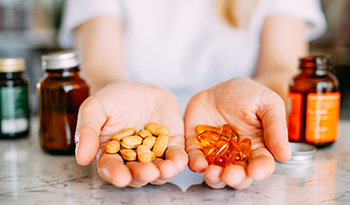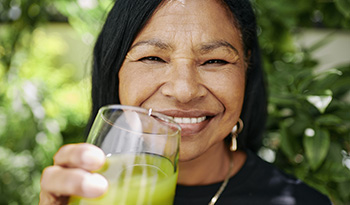Here’s Why an ND Recommends Using a Fruit and Vegetable Wash

What Are Common Food Contaminants?
We may not think about it because we can’t see, taste, or observe food contaminants, but many foods, especially fruits and vegetables, can have unwanted elements on them.
Chemical Contaminants
Chemical contamination is the most common category of food contaminants. These chemicals are concerning when present in foods or in higher amounts that exceed toxic limits.
Chemical contaminants have many sources, including soil, pesticides, plastics, air, water, metals, and packaging material. Chemical contaminants can be associated with foodborne illnesses.
From 2009-2010, according to the Centers for Disease Control and Prevention (CDC), 1,527 cases of foodborne illnesses were recorded. These outbreaks lead to illness and gastrointestinal problems. Processing fruits and vegetables from farm to table takes a long time, which can contribute to illnesses. Transportation of foods, harvest, storage or intentional contamination through pesticides are all common sources of food contaminants.
Food coming in direct contact with packaging materials containing toxic substances like Bisphenol A or BPA plastics can cause the packing material chemicals to leach into foods. Sources of pollution like diesel fumes from trucks or disinfectants in ship cargo areas can also contaminate the surfaces of foods.
Bacteria, Viruses, and Parasites
In addition to chemical contamination, naturally occurring contaminants like bacteria, viruses, and parasites are often present on the surfaces of raw foods. Contamination with these organisms can occur when food is in contact with sewage, human handling, or live animals. Some common organisms found on fruits and vegetables include Toxoplasma gondii and Giardia gondii.
Heavy Metals
Heavy metals from supply chain sources in and around certain areas can also contaminate foods. Metals like mercury, cadmium, and lead often get used in industrial processes like smelting. These metals can easily enter the soil. At the bottom of the food chain, plants often are the first ones to contact these metals.
Pesticides
Three billion kilograms of pesticides intentionally get added to plant food sources annually to prevent the destruction of these crops. Pesticide residues often linger on fruits and vegetables and can easily be consumed by consumers.
What Is a Fruit and Vegetable Wash?
A fruit and vegetable wash is a cleaning product that aids in removing dirt, pesticides, and other materials from fruits and vegetables before consumption. Many commercial products contain surfactants, cheating (think: binding for heavy metal removal) agents, and antioxidants. These compounds can help to remove heavy metals from the body or break up pesticides structures.
Health Effects of Food Contamination
Pesticide application remains controversial, as legal limits of pesticide residue work to protect consumers. Other viewpoints say no amount of pesticide residues is healthy and have correlated unwanted pesticide consumption with many disease states/symptoms. Some studies have associated the use of these chemicals with immune suppression, neurological symptoms, hormone disruption, and fertility issues.
Glyphosate, a common weed killer or herbicide, has been associated with increased cell proliferation in humans. This compound works to inhibit an enzyme called 5-EPSP synthase in plants and bacteria. That prevents the utilization of amino acids to create proteins. Without access to these proteins, weeds die off.
Within the human body, many bacteria, good and disruptive, live in the gastrointestinal system. This collection of microorganisms is called the microbiome. Glyphosate has been shown to decrease the number of good bacteria, while harmful bacteria like Clostridium species and Salmonella strains seem to be resistant to the chemical. Researchers have suggested that glyphosate consumption leads to dysbiosis, or more bad than good bacteria, in the gut. Some studies have correlated dysbiosis with increased neurotoxic metabolites, in other words, things that can affect the brain and nervous system negatively.
BPA is a common ingredient in plastics and polymers. Until recently, BPA plastics got widely used as packaging material. This compound can enter into the body via food consumption and act as an endocrine or hormone disruptor. BPA has estrogen and androgen (think: testosterone family of hormones) properties, which can be correlated with reproductive abnormalities, immune system suppression, and neurological symptoms. Studies also suggest that BPA has cell proliferative properties.
Heavy metals from contamination can disrupt metabolomics in humans or many physiological functions. Heavy metals are reactive in the body as they often contain too few electrons, or energy molecules, to be stable. So these metals “steal” electrons from human cells and tissues. This “stealing” action leads to oxidative stress, which can damage tissues and cause more chronic issues and disease systems. The best real-life example of oxidative stress is when you cut open an apple and leave it out. The normal air oxidizes the apple and causes it to turn brown. That is precisely what happens inside the body, but instead of turning the cells/tissues an unwanted color, it damages them.
Microorganisms or toxin products can also cause foodborne illnesses, including stomach upset or “food poisoning.” Organisms like viruses, bacteria, and parasites may contaminate food products. Parasites can be in foods in developing countries as well as modern societies. Some studies have shown Cryptosporidium, a microscopic parasite has been present in lettuce and mung bean samples of food. Giardia contamination had been seen in mung beans, dill, radish, and strawberries. Some of these sources get traced back to the water supply.
Why Use a Fruit and Vegetable Wash?
A few types of fruit and vegetable washes are commercially available. One ingredient that may get found in these washes is rosemary oil. This compound has natural antimicrobial properties. In studies, the application of rosemary oil has successfully killed bacteria, fungi, and parasites on various surfaces.
Glycerols or glycerin is a compound with an alcohol base, usually odorless and slightly sweet tasting. This element of many fruit and vegetable washes acts as a surfactant, working to dissolve chemicals. Studies have shown that the use of glycerin-based solutions has reduced topical pesticide residue by 50%. It also has antimicrobial properties and can be used safely in medicine to treat burn wounds.
Some washes also include calcium ascorbate or other vitamin C derivatives. This additive can absorb into fruits and vegetables, increasing their antioxidant content. Antioxidants are key in preventing damage to the cells and body from food contaminants. They are also key players in many physiological functions of the body—a win-win!
Limonene is another common ingredient found in fruit and vegetable washes. This naturally occurring oil derived from citrus fruits has been used in the agricultural industry as a substitute for pesticides. This oil has anti-microbial, herbicidal, and antioxidant properties. It also gets used in the beverage and food industry to flavor drinks and various products.
Citric acid is an ingredient used as well and has many widespread uses in the food industry and other industries. A natural antioxidant and food stabilizer, this additive can have the dual benefit of protecting against food contamination damage in the body and providing preservation for foods and vegetables.
Sea salt is a simple but effective antimicrobial. This common condiment is a natural solution to kill off unwanted bacteria. Spraying or washing a bacteria or other microbe with a salt-containing solution causes the water to leave the organism. Eventually, without water, the organism dies. Salt works to essentially protect us from unwanted microbes or toxic microbe products in our food.
Caprylyl glucoside is a compound also found in these washes and acts as a surfactant to break down unwanted elements that are not very water-soluble. One of these elements includes pesticide residue. Pesticides are often petroleum-based, meaning they are fat-soluble rather than water-soluble. Surfactants can help to break down these difficult to metabolize compounds.
Sunflower seed oil gets found in some preparations of fruit and vegetable washes. This naturally derived compound has been reported to contain antioxidants, antimicrobials, and properties that support healthy inflammatory levels. In studies, the application of this oil on wounds has shown better responses than commercially prepared solutions. This compound has demonstrated anti-microbial properties against bacterial and yeast species.
Takeaway
Food contaminants get widely found in many fruits and vegetables we eat. These contaminants, including microbes, heavy metals, pesticides, and plastics are unwanted and can have adverse effects on our health. Thankfully products like fruit and vegetable washes support easy removal of these unwanted contaminants.
References:
- Rather IA, Koh WY, Paek WK, Lim J. The Sources of Chemical Contaminants in Food and Their Health Implications. Front Pharmacol. 2017;8:830. Published 2017 Nov 17. doi:10.3389/fphar.2017.00830
- Abhilash PC, Singh N. Pesticide use and application: an Indian scenario. J Hazard Mater. 2009;165(1-3):1-12. doi:10.1016/j.jhazmat.2008.10.061
- Rueda-Ruzafa L, Cruz F, Roman P, Cardona D. Gut microbiota and neurological effects of glyphosate. Neurotoxicology. 2019;75:1-8. doi:10.1016/j.neuro.2019.08.006
- Ma Y, Liu H, Wu J, et al. The adverse health effects of bisphenol A and related toxicity mechanisms. Environ Res. 2019;176:108575. doi:10.1016/j.envres.2019.108575
- Rai PK, Lee SS, Zhang M, Tsang YF, Kim KH. Heavy metals in food crops: Health risks, fate, mechanisms, and management. Environ Int. 2019;125:365-385. doi:10.1016/j.envint.2019.01.067
- Robertson LJ, Gjerde B. Occurrence of parasites on fruits and vegetables in Norway. J Food Prot. 2001;64(11):1793-1798. doi:10.4315/0362-028x-64.11.1793
- Wu Y, An Q, Li D, Wu J, Pan C. Comparison of Different Home/Commercial Washing Strategies for Ten Typical Pesticide Residue Removal Effects in Kumquat, Spinach and Cucumber. Int J Environ Res Public Health. 2019;16(3):472. Published 2019 Feb 6. doi:10.3390/ijerph16030472
- Jiang Y, Wu N, Fu YJ, et al. Chemical composition and antimicrobial activity of the essential oil of Rosemary. Environ Toxicol Pharmacol. 2011;32(1):63-68. doi:10.1016/j.etap.2011.03.011
- Zoral MA, Futami K, Endo M, Maita M, Katagiri T. Anthelmintic activity of Rosmarinus officinalis against Dactylogyrus minutus (Monogenea) infections in Cyprinus carpio. Vet Parasitol. 2017;247:1-6. doi:10.1016/j.vetpar.2017.09.013
- Bajwa U, Sandhu KS. Effect of handling and processing on pesticide residues in food- a review. J Food Sci Technol. 2014;51(2):201-220. doi:10.1007/s13197-011-0499-5
- Dewhirst RA, Clarkson GJJ, Rothwell SD, Fry SC. Novel insights into ascorbate retention and degradation during the washing and post-harvest storage of spinach and other salad leaves. Food Chem. 2017;233:237-246. doi:10.1016/j.foodchem.2017.04.082
- Ibáñez MD, Sanchez-Ballester NM, Blázquez MA. Encapsulated Limonene: A Pleasant Lemon-Like Aroma with Promising Application in the Agri-Food Industry. A Review. Molecules. 2020;25(11):2598. Published 2020 Jun 3. doi:10.3390/molecules25112598
- Ciriminna R, Meneguzzo F, Delisi R, Pagliaro M. Citric acid: emerging applications of key biotechnology industrial product. Chem Cent J. 2017;11:22. Published 2017 Mar 8. doi:10.1186/s13065-017-0251-y
- Wijnker JJ, Koop G, Lipman LJ. Antimicrobial properties of salt (NaCl) used for the preservation of natural casings. Food Microbiol. 2006;23(7):657-662. doi:10.1016/j.fm.2005.11.004
- Fiume MM, Heldreth B, Bergfeld WF, et al. Safety assessment of decyl glucoside and other alkyl glucosides as used in cosmetics. Int J Toxicol. 2013;32(5 Suppl):22S-48S. doi:10.1177/1091581813497764
- Rodrigues KL, Cardoso CC, Caputo LR, Carvalho JC, Fiorini JE, Schneedorf JM. Cicatrizing and antimicrobial properties of an ozonised oil from sunflower seeds. Inflammopharmacology. 2004;12(3):261-270. doi:10.1163/1568560042342275
ANSVARSFRASKRIVELSE:Velværesenteret har ikke til hensikt å gi diagnoser ...













































































 Innholdsfortegnelse
Innholdsfortegnelse














